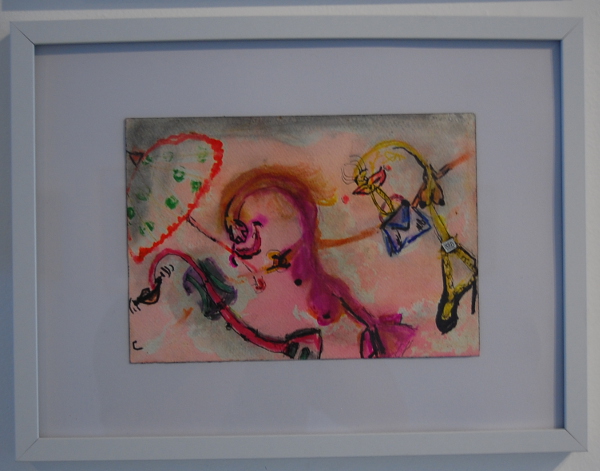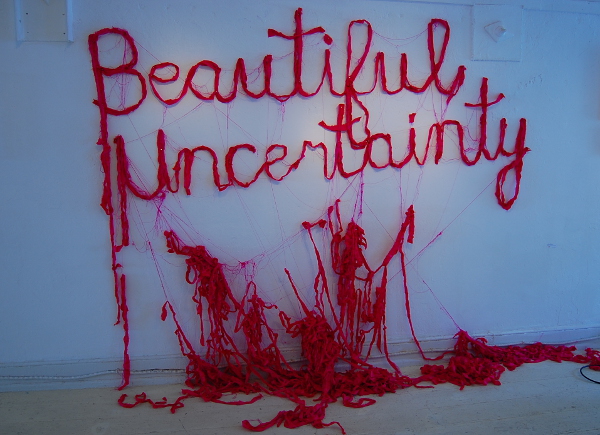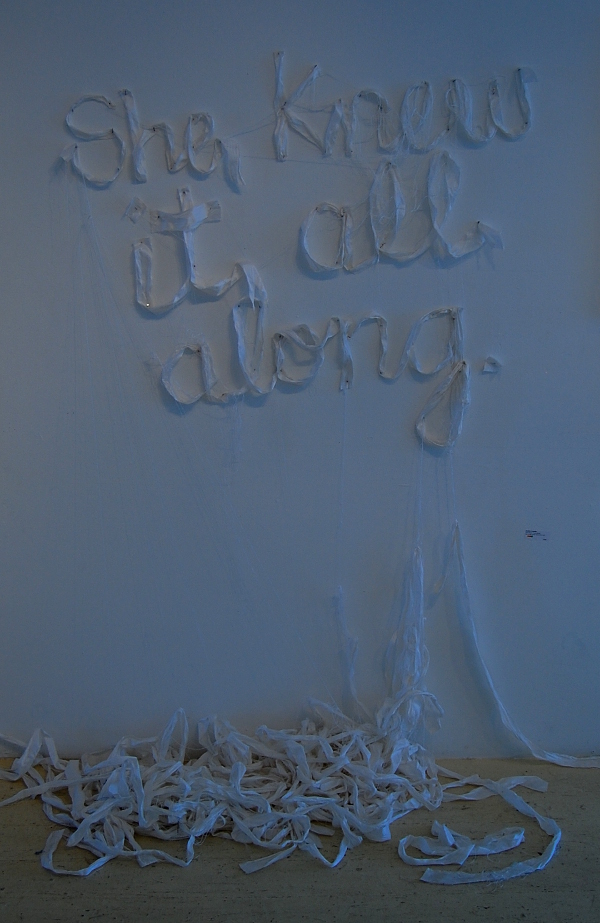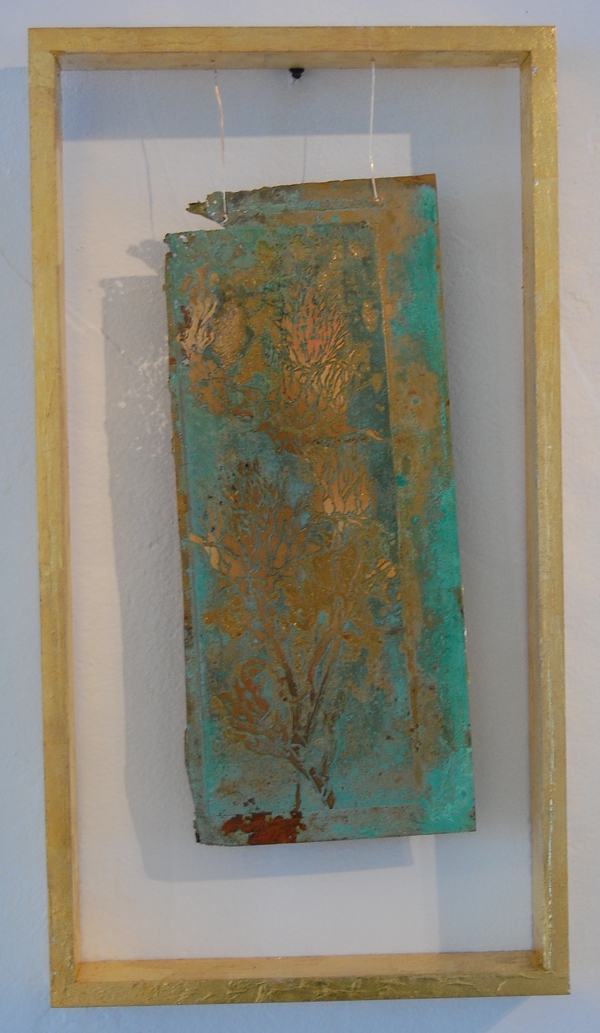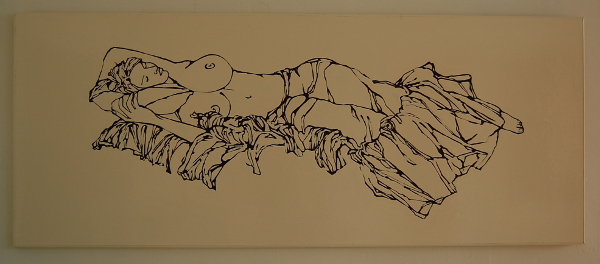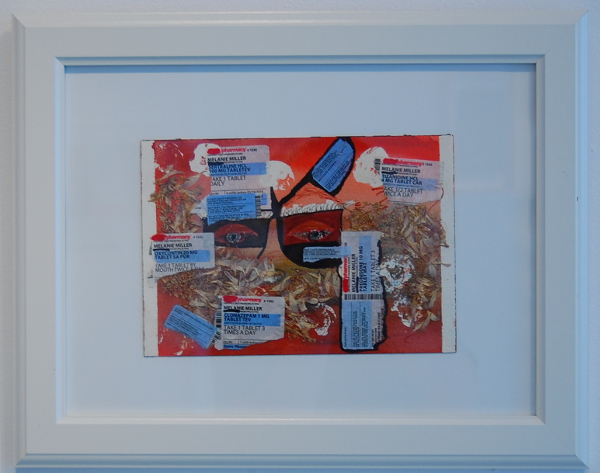
Unraveling “Illumination” at James Oliver Gallery easier said than done
At James Oliver Gallery, artists Denise Fike, Melanie Miller and Aubrie Costello deck out the white walls with fabric, sketches and printmaking materials for the show “Illumination.” Each has a completely different take on the making process, and through their experimentation, a pensive and occasionally chaotic exhibit emerges from the assembled ideas and methods.
Of the works in the show, a majority are the products of Melanie Miller. These mostly small, white-framed drawings run the range of emotional and psychological outpourings, which seem like a direct line into the artist’s brain. Miller, a former dancer, harnesses the trial of her own physical disability into a moving series of paint and pencil that attempts to get to the root of human weakness and bodily deterioration. Many pieces incorporate labels from prescription drugs or titles such as “Ketamine Coma,” placing the sometimes taboo topic of medication at the forefront of her content.
Melanie Miller, “Promenade of the Cane Ladies.”
Concerning the formal elements of Miller’s work, much of it is scrawled and labeled in a very stream-of-consciousness style reminiscent of a sketchbook or Cy Twombly painting. She also takes surreal detours with images such as “Promenade of the Cane Ladies.” Here, the cane is certainly further representative of physical disability, but a spark of humor emerges from the depiction of – not ladies with canes – but actual cane forms dressed and posed as ladies, complete with lips, handbags, and even a parasol.
Aubrie Costello, “Beautiful Uncertainty.”
Aubrie Costello breaks up the prevalence of quadrilateral frames in the space by draping swaths of fabric from the walls and onto the floor. After hand ripping these sheets of cloth, the artist proceeds to form them into letters, words and phrases, which she then nails directly to the wall. The cryptic statements offer a lot of interpretation on the part of the viewer, and one wonders if the artist herself is even aware of what these snippets of thought could mean for certain.
Aubrie Costello, “She Knew It All Along.”
Like Miller’s surfacing subconscious, we are ushered into the complex territory of another person’s perspective which we will never fully grasp. Miller seems to meet this disconnect by continually pouring content onto her pages but Costello takes it to a more physical and even violent level. The very act of tearing cloth is inherently destructive even when the end result is art, and her method of mounting with nails is piercing, permanently altering, and more like crucifixion than, say, delicately draping the strips over hooks or other fixtures.
Denise Fike, “Artichoke Bloom.”
Instead of actually displaying prints, Denise Fike chooses to hang the framed metal plates that she utilizes to create these images. Seeing these artifacts, one becomes aware that they are all reversals of how the prints themselves would appear, twisting the result into a mirrored opposite. The metal is also pocked and eaten away by the acids used in the process, and green patina covers the surfaces in some places, bestowing them with beautiful natural textures and depths that would otherwise be invisible in the final print.
Denise Fike, “Afterglow.”
Fike also includes a number of metallic floral arrangements on tall panels which hint at the artist’s preoccupation with wallpaper, patterning, and interior design. Slightly behind and to the left of a series of these panels assembled as a folding changing screen is the outline of a nude woman taken directly from the plate entitled “Afterglow.” Interestingly enough, this piece of the same title is much larger than the print would be and is actually a painting. This misdirection hints at the presence of actual prints but stops short of actually including them in the show, as a sort of practical joke on the observer.
All three artists create work that resides amidst layers of personal meaning and visual artifice. In the same space, they clash with one another by providing textural tropes on the making process, internal monologues, and words which meander down the walls into piles of meaningless threads. Needless to say, unraveling this exhibit is easier said than done. There will be a closing reception for “Illumination” on August 16 from 6-9 p.m.
James Oliver Gallery is located at 723 Chestnut St., Philadelphia; [email protected]; jamesolivergallery.com.
Recent Content
-
Artsarticle ·
-
Artsarticle ·
-
Artsarticle ·
